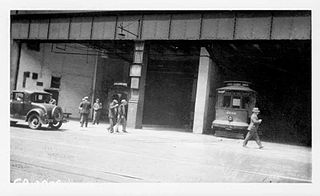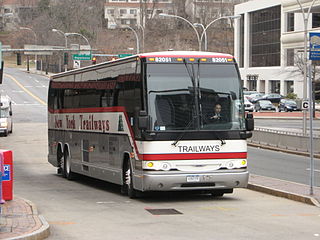Related Research Articles

The Rochester Industrial and Rapid Transit Railway, more commonly known as the Rochester subway, was a light rail rapid transit line in the city of Rochester, New York that operated from 1927 to 1956. The subway was constructed in the bed of the old Erie Canal, which allowed the route to be grade-separated for its entire length. Two miles (3.2 km) of the route through downtown were constructed in a cut-and-cover tunnel that became Broad Street, and the only underground portion of the subway. The Rochester Subway was designed to reduce interurban traffic on city streets, and to facilitate freight interchange between the railroads. The line was operated on a contract basis by New York State Railways until Rochester Transit Corporation (RTC) took over in 1938. The last day of passenger service was June 30, 1956. Portions of the right-of-way were used for expressway construction, while the rest was abandoned and filled in over the years. The largest remaining section is a stretch of tunnel under Broad Street from Exchange Street to the intersection of Court Street and South Avenue.

The Steinway Tunnel is a pair of tubes carrying the IRT Flushing Line of the New York City Subway under the East River between 42nd Street in Manhattan and 51st Avenue in Long Island City, Queens, in New York City. It was originally designed and built as an interurban trolley tunnel, with stations near the current Hunters Point Avenue and Grand Central stations.

New York State Railways was a subsidiary of the New York Central Railroad that controlled several large city streetcar and electric interurban systems in upstate New York. It included the city transit lines in Rochester, Syracuse, Utica, Oneida and Rome, plus various interurban lines connecting those cities. New York State Railways also held a 50% interest in the Schenectady Railway Company, but it remained a separate independent operation. The New York Central took control of the Rochester Railway Company, the Rochester and Eastern Rapid Railway and the Rochester and Sodus Bay Railway in 1905, and the Mohawk Valley Company was formed by the railroad to manage these new acquisitions. New York State Railways was formed in 1909 when the properties controlled by the Mohawk Valley Company were merged. In 1912 it added the Rochester and Suburban Railway, the Syracuse Rapid Transit Railway, the Oneida Railway, and the Utica and Mohawk Valley Railway. The New York Central Railroad was interested in acquiring these lines in an effort to control the competition and to gain control of the lucrative electric utility companies that were behind many of these streetcar and interurban railways. Ridership across the system dropped through the 1920s as operating costs continued to rise, coupled with competition from better highways and private automobile use. New York Central sold New York State Railways in 1928 to a consortium led by investor E. L. Phillips, who was looking to gain control of the upstate utilities. Phillips sold his stake to Associated Gas & Electric in 1929, and the new owners allowed the railway bonds to default. New York State Railways entered receivership on December 30, 1929. The company emerged from receivership in 1934, and local operations were sold off to new private operators between 1938 and 1948.

The Third Avenue Railway System (TARS), founded 1852, was a streetcar system serving the New York City boroughs of Manhattan and the Bronx along with lower Westchester County. For a brief period of time, TARS also operated the Steinway Lines in Long Island City.

The Connecticut Company was the primary electric street railway company in the U.S. state of Connecticut, operating both city and rural trolleys and freight service. It was controlled by the New York, New Haven and Hartford Railroad, which also controlled most steam railroads in the state. After 1936, when one of its major leases was dissolved, it continued operating streetcars and, increasingly, buses in certain Connecticut cities until 1976, when its assets were purchased by the state government.
The 17th and 18th Streets Crosstown Line was a public transit line in Manhattan, New York City, United States, running mostly along 14th Street, 17th Street, and 18th Street from the West 14th Street Ferry in Chelsea and Christopher Street Ferry in the West Village to the East 23rd Street Ferry at Peter Cooper Village. It was not replaced with a trolley line or bus route when it was abandoned in 1913.
The Adams Street and Boerum Place Line was a public transit line in Downtown Brooklyn, New York City, United States, running along Boerum Place and Adams Street. It served as access for the Atlantic Avenue Railroad to the City Hall area.

The Lenox Avenue Line is a surface transit line on Lenox Avenue in Harlem, Manhattan, New York City, United States. The line was once operated separately, but later became the northern end of the Broadway and Columbus Avenue Line and Broadway and Lexington Avenue Line, now the M7 and M102 bus routes.
The Syracuse and Binghamton Railroad was established on August 18, 1851, and opened for business on October 18, 1854. The road merged in 1856 into Syracuse and Southern Railroad which was renamed to Syracuse, Binghamton and New York Railroad when the company reorganized after foreclosure in 1857.
The Syracuse, Lake Shore and Northern Railroad, an interurban railway, was incorporated on September 9, 1905, after it was purchased by the Beebe Syndicate. The line ran from Syracuse, New York, to Baldwinsville, New York, a distance of 14 miles (23 km) with a short branch to the New York State Fair grounds ending at Long Branch Park west of the city for a total of 23.53 miles (37.87 km) of electric track.
The Syracuse, Eastwood Heights and DeWitt Railroad, an interurban rail in Syracuse, New York was established in 1859. This was one of the most important of the first lines and operated as a steam road. The company was awarded the operation rights for the Burnet Avenue route as well as the Burnet Street Car Company.
The Genesee and Water Street Railroad, a horse-drawn street trolley in Syracuse, New York, was established in 1865. The company was one of three different railways that were awarded operation franchise rights to run cars in James Street. The firm also secured the franchise to operate cars in Westcott Street, to South Beech Street, Euclid Avenue, College Place, University Place, Walnut Avenue and Madison Street.
The Syracuse and Geddes Railway, a horse-drawn street trolley in Syracuse, New York, was chartered on July 10, 1863. The line ran from Syracuse to Geddes, a suburb. The route ran from Salina Street and Fayette Street to Hemlock, Bridge and Furnace Street.
The New Brighton and Onondaga Valley Railroad, a horse-drawn street trolley line, was chartered on May 5, 1869, in Syracuse, New York. The road was also known as the New Brighton and Onondaga Railroad.
The Seventh Ward Railroad, a street trolley line in Syracuse, New York, was established in 1886 and held the city railway franchise rights to East Fayette Street. The total length of the road was 3 miles (4.8 km). The route followed Fayette Street from Salina Street to Montgomery Street, Jefferson, Grape, Kennedy, Renwick Avenue with final destination Oakwood Cemetery.
The Eleventh Ward Railroad, a street trolley line in Syracuse, New York, was established in 1889 and held the city railway franchise rights to East Fayette Street. The line followed East Fayette Street to Montgomery Street and from there through Burt, Cortland Avenue, Midland Avenue, Colvin Street, Mulberry, Elizabeth, Baker Avenue and terminating on Kennedy street.
The Utica and Mohawk Valley Railway was the result of the unification of all city and suburban streetcar lines serving Utica, New York, on November 27, 1901. The railway operated city streetcar service as well as a double-track interurban railway between Rome and Little Falls via Utica. The Utica and Mohawk Valley Railway was merged into New York State Railways in 1912. At its peak, the Utica Lines consisted of 17 transit routes operated with more than 100 cars. The line ceased operation in 1933, except for the section between Utica and Whitesboro that survived until 1938. The last city streetcars operated on May 31, 1941. The remaining transit routes were operated with buses and the franchise would be reorganized as the Utica Transit Corporation in 1948.

The Peekskill Lighting and Railroad Company was a streetcar transit line operating in northern Westchester County and southern Putnam County, New York. The earliest segment was constructed by the Peekskill Traction Company in 1899, running 5.5 miles (8.9 km) from the New York Central Railroad train station at Peekskill to Lake Mohegan. The company was unable to meet payments for construction of the line, so the contractor operated the railroad until it was sold to the Peekskill Lighting and Railroad Company in 1900. The associated Westchester and Putnam Traction Company built extensions beyond Lake Mohegan, though the two companies were operated as one. In 1902, an extension was constructed through Buchannan to Verplanck. Another extension was opened in 1907 to Cortlandville, and Varian's Mills in 1908. The final extension to Oregon opened in 1909. President of the company was F.A. Stratton, who was also president of the Hudson River and Eastern Traction company, operators of the Ossining Electric Railway.

The White Plains TransCenter is an intermodal transit center in White Plains, New York. It serves as a terminal/transfer point for many Bee-Line Buses, as well as intercity buses, and taxicabs. The terminal is located along Ferris Avenue north of Hamilton Street, diagonally across from the White Plains station of Metro-North Railroad, and includes a parking garage located next door to the railroad station, across that street. Ferris Avenue is a one-way street north of Main Street, and is flanked by northbound and southbound buses only lanes between Hamilton Street and Water Street.
References
- ↑ "Study for Bus Franchise Recalls Early Trolley Lines". Syracuse Herald-Journal . Syracuse, New York. May 23, 1940.
- 1 2 Bruce, Dwight Hall. Memorial history of Syracuse, N.Y., from its settlement to the present time. Electronic Library, 2011. Archived from the original on October 12, 2012. Retrieved July 5, 2011.